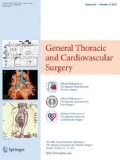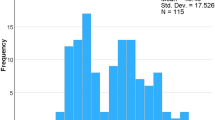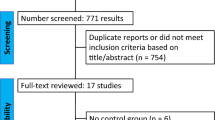Abstract
Background
Deep sternal wound infection (DSWI) is a critical complication of cardiovascular surgery. This study aimed to confirm the efficacy of new, multimodal preventive measures for post-operative DSWI.
Methods
From January 2008 to December 2012, 1240 patients underwent cardiovascular surgery via median sternotomy at our hospital. The patients were divided into two groups according to the period in which surgery was performed: those treated before and those treated after January 2011, which was when we implemented the new preventive measures against DSWI. The preventive measures included routine use of an off-pump technique in coronary artery bypass grafting, higher body temperature of pump cases, screening and pre-operative eradication of nasal methicillin-resistant Staphylococcus aureus colonization, and use of a microbial sealant. We compared the incidence of DSWI between the two time periods. Univariate and multivariate analyses were also performed for the entire period to identify DSWI risk factors.
Results
Only 1 case (0.2%) of DSWI was noted among 554 patients in the latter period while 25 patients (3.6%) experienced DSWI among the 686 patients in the earlier period (p < 0.0001). The risk factors for DSWI were body mass index (BMI) ≥ 25 kg/m2 and operation time ≥ 8 h.
Conclusions
We observed a marked decrease in the incidence of DSWI after the implementation of multimodal preventive measures. The risk factors for DSWI were BMI ≥ 25 kg/m2 and operation time ≥ 8 h.
Similar content being viewed by others
References
Abboud CS, Wey SB, Baltar VT. Risk factors for mediastinitis after cardiac surgery. Ann Thorac Surg. 2004;77:676–83.
Trouillet JL, Vuagnat A, Combes A, Bors V, Chastre J, Gandjbakhch I, et al. Acute poststernotomy DSWI managed with debridement and closed-drainage aspiration: factors associated with death in the intensive care unit. J Thorac Cardiovasc Surg. 2005;129:518–24.
Shafir R, Weiss J, Herman O, Cohen N, Stern D, Igra Y. Faulty sternotomy and complications after median sternotomy. J Thorac Cardiovasc Surg. 1989;96:310–3.
Loop FD, Lytle BW, Cosgrove DM, Mahfood S, McHenry MC, Goormastic M, et al. J Maxwell Chamberlain memorial paper. Sternal wound complications after isolated coronary artery bypass grafting: early and late mortality, morbidity, and cost of care. Ann Thorac Surg. 1990;49:179–86.
El Oakley RM, Wright JE. Postoperative mediastinitis: classification and management. Ann Thorac Surg. 1996;61:1030–6.
Davison SP, Clemens MW, Armstrong D, Newton ED, Swartz W. Sternotomy wounds: rectus flap versus modified pectoral reconstruction. Plast Reconstr Surg. 2007;120:929–34.
ISO 14644-1. Cleanrooms and associated controlled environments—part 1: classification of air cleanliness by particle concentration; 2015.
FED-STD-209E. Federal standard, Airborne particulate cleanliness in cleanrooms and clean zone; 1992.
Cosgrove DM, Lytle BW, Loop FD, Taylor PC, Stewart RW, Gill CC, et al. Does bilateral internal mammary artery grafting increase surgical risk? J Thorac Cardiovasc Surg. 1988;95:850–6.
Kouchoukos NT, Wareing TH, Murphy SF, Pelate C, Marshall WG Jr. Risks of bilateral internal mammary artery bypass grafting. Ann Thorac Surg. 1990;49:210–9 (discussion 217–219).
Milano CA, Kesler K, Archibald N, Sexton DJ, Jones RH. Mediastinitis after coronary artery bypass graft surgery. Risk factors and long-term survival. Circulation. 1995;92:2245–51.
Kohli M, Yuan L, Escobar M, David T, Gillis G, Garcia M, et al. A risk index for sternal surgical wound infection after cardiovascular surgery. Infect Control Hosp Epidemiol. 2003;24:17–25.
Dronge AS, Perkal MF, Kancir S, Concato J, Aslan M, Rosenthal RA. Long-term glycemic control and postoperative infectious complications. Arch Surg. 2006;141:375–80.
Shomura Y, Okada Y, Shinkai N, Nasu M, Fujiwara H, Koyama T, et al. Surgical site infection in cardiovascular surgery: cooperation between the infection control team and surgeons. Jpn J Cardiovasc Surg. 2013;42:377–83.
Berríos-Torres SI, Umscheid CA, Bratzler DW, Leas B, Stone EC, Kelz RR, et al. Centers for disease control and prevention guideline for the prevention of surgical site infection, 2017. JAMA Surg. 2017;152:784–91.
Culver DH, Horan TC, Gaynes RP, Martone WJ, Jarvis WR, Emori TG, et al. Surgical wound infection rates by wound class, operative procedure, and patient risk index. National Nosocomial Infections Surveillance System. Am J Med. 1991;91:152S–7S.
Tentative final monograph for health-care antiseptic drug products 21 CFR parts 333 and 369. Federal Register, Friday, June 17, 1994; section, 333.412; p. 31450.
Kurz A, Sessler DI, Lenhardt R. Perioperative normothermia to reduce the incidence of surgical-wound infection and shorten hospitalization. Study of Wound Infection and Temperature Group. N Engl J Med. 1996;334:1209–15.
Van Oss CJ, Absolom DR, Moore LL, Park BH, Humbert JR. Effect of temperature on the chemotaxis, phagocytic engulfment, digestion and O2 consumption of human polymorphonuclear leukocytes. J Reticuloendothel Soc. 1980;27:561–5.
Schubert A. Side effects of mild hypothermia. J Neurosurg Anesthesiol. 1995;7:139–47.
Chong TW, Sawyer R. Update on the epidemiology and prevention of surgical site infections. Curr Infect Dis Rep. 2002;4:484–90.
Dindo D, Muller MK, Weber M, Clavien PA, et al. Obesity in general elective surgery. Lancet. 2003;361:2032–5.
Brachman PS. Nosocomial infection-airborne or not? In: Brachman, PS, Eickhoff, TC, editors. Proceedings of the international conference on nosocomial infections. Chicago, IL: American Hospital Association; 1971:189–92.
Lidwell OM, Lowbury EJL, Whyte W, Blowers R, Stanley SJ, Lowe D. Effect of ultraclean air in operating rooms on deep sepsis in the joint after total hip or knee replacement: a randomized study. Br Med J. 1982;285:10–4.
Lidwell OM. Sepsis after total hip or knee joint replacement in relation to airborne contamination. Philos Trans R Soc B. 1983;302:583–92.
Humphreys H. Preventing surgical site infection. Where now? J Hosp Infect. 2009;73:316–22.
Mangram AJ, Horan TC, Pearson ML, Silver LC, Jarvis WR, Guideline for Prevention of Surgical Site Infection. Centers for Disease Control and Prevention (CDC) Hospital Infection Control Practices Advisory Committee. Am J Infect Control. 1999;1999(27):97–132.
Sehulster L, Chinn RY, CDC; HICPAC. Guidelines for environmental infection control in health-care facilities. Recommendations of CDC and the Healthcare Infection Control Practices Advisory Committee (HICPAC). MMWR Recomm Rep. 2003;52:1–42.
ANSI/ASHRAE/ASHE. Standard 170—ventilation of health care facilities; 2008.
Lidwell OM, Elson RA, Lowbury EJ, Whyte W, Blowers R, Stanley SJ, et al. Ultraclean air and antibiotics for prevention of postoperative infection. A multicenter study of 8052 joint replacement operations. Acta Orthop Scand. 1987;58:4–13.
Acknowledgements
All authors would like to thank Noriko Shinkai for prevention and management of SSIs in our hospital. She also supported data collection for this article.
Author information
Authors and Affiliations
Corresponding author
Ethics declarations
Conflict of interest
All authors have no financial interest for the drugs or products mentioned in this article.
Additional information
Publisher's Note
Springer Nature remains neutral with regard to jurisdictional claims in published maps and institutional affiliations.
Rights and permissions
About this article
Cite this article
Konishi, Y., Fukunaga, N., Abe, T. et al. Efficacy of new multimodal preventive measures for post-operative deep sternal wound infection. Gen Thorac Cardiovasc Surg 67, 934–940 (2019). https://doi.org/10.1007/s11748-019-01139-x
Received:
Accepted:
Published:
Issue Date:
DOI: https://doi.org/10.1007/s11748-019-01139-x




